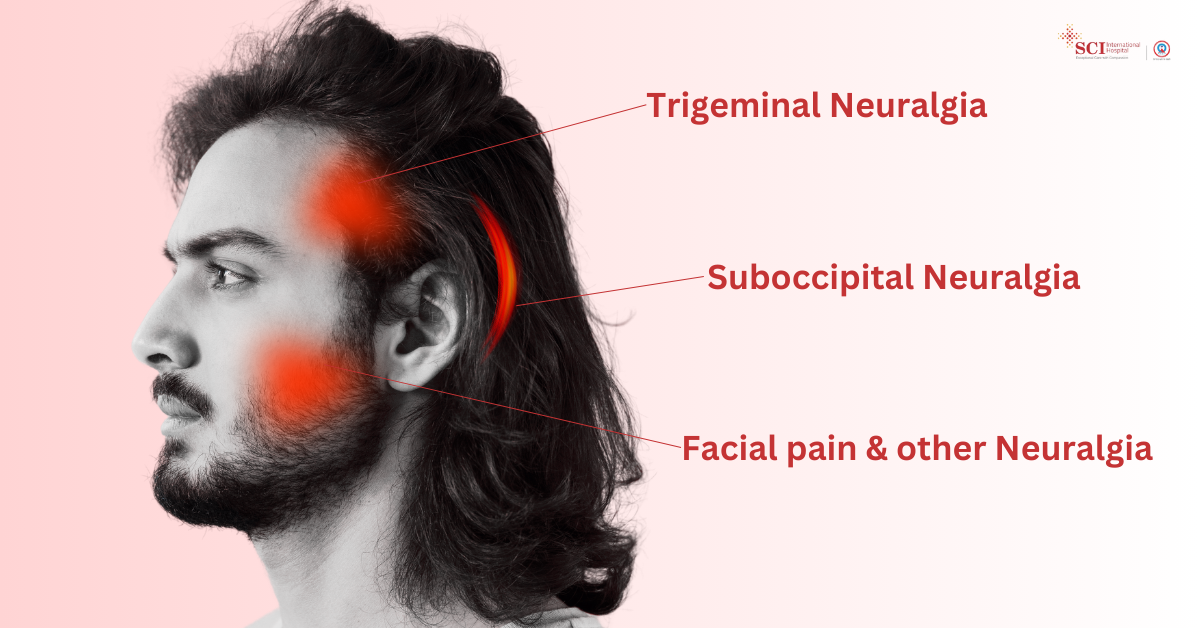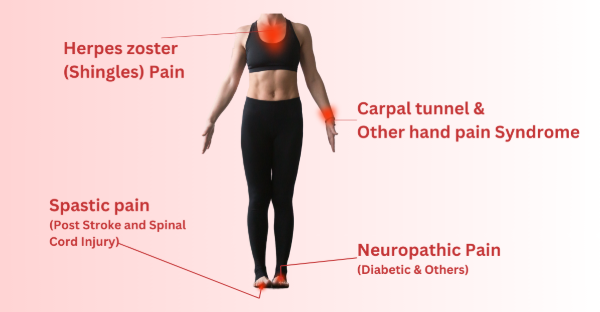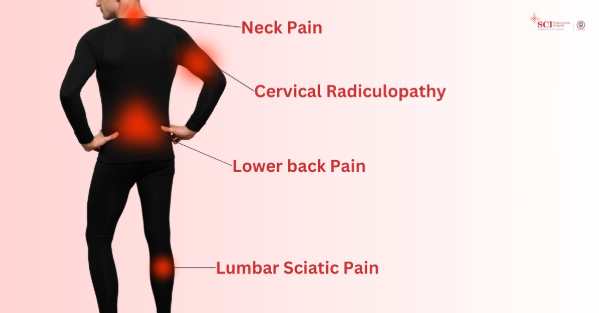COMMON TYPES
OF CHRONIC PAIN
Neck and Back Pain Conditions
These are common problems that can be caused by poor posture, prolonged sitting and old injuries. When this is ignored and left without treatment, it can lead to chronic discomfort and restricted movement:
- Neck Pain: This can be caused by poor posture, stress, long hours of screen time, or sudden jerks. It can lead to stiffness around the neck, reduced movement, and headaches.
- Cervical Radiculopathy: When the nerves in the neck become compressed due to herniated discs or bone spurs, it can cause shooting pain, weakness, or numbness in the arms and hands.
- Lower Back Pain:A very common issue caused by muscle strain, sitting for long periods, improper lifting, or aging. It can make daily activities like bending, walking, or sitting painful.
- Lumbar Sciatic Pain: This occurs when the sciatic nerve is affected. It causes sharp pain, tingling, or weakness in the legs and lower back.
Treatment Options
for Neck and Back Pain Conditions
Medication & Physiotherapy: Pain relief medicines, muscle relaxants, and guided exercises help manage pain and improve mobility over time. Epidural Block: A precise injection near the spine that reduces swelling and inflammation, helping with severe back and leg pain. Selective Nerve Root Block: An injection that directly targets an inflamed nerve to relieve pain and restore movement. Cervical Root Block: A nerve block specifically for the neck area to reduce pain, numbness, or weakness caused by compressed nerves. Spinal Cord Stimulation: A small device is placed near the spine to send minute electrical signals to the spinal cord. It blocks the signals which cause the pain before they reach the brain.
Chronic Headaches
& Migraine
- Most people have headaches occasionally, but if you have a headache more days than not, you might have chronic daily headaches. By definition, Chronic daily headaches occur 15 days or more a month, for longer than three months. There are short-lasting and long-lasting chronic headaches. Long-lasting headaches last more than four hours. They include:
Chronic tension-type headache Chronic Migraine New daily persistent headache Hemicrania Continua
- Chronic tension-type headache tends to affect both sides of your head, causing mild to moderate pain, pain that feels pressing or tightening.
- Chronic Migraine typically occurs in people with a history of episodic migraines. Chronic migraines tend to affect one side or sometimes both sides of the head, have a pulsating, throbbing sensation and cause moderate to severe pain. These headaches are associated with nausea, vomiting, and sensitivity to light and sound.
- New daily persistent headache comes on suddenly, usually in people without a headache history. They become constant within three days of your first headache. These headaches often affect both sides of your head, feel like pressing or tightening and cause mild to moderate pain.
- Hemicranial Continua headache affects only one side of your head, is daily and Continuous with no pain free periods. They cause moderate pain with spikes of severe pain. They are associated with tearing or redness of the eye on the affected side, nasal congestion, drooping of eyelids and sensation of restlessness.
- Medication overuse headache: This type of headache usually develops in people who have an episodic headache disorder and take too much pain medication. They are at risk of developing rebound headaches.
Treatment options
for Chronic Migraine and other headaches
When to see a doctor
Occasional headaches are common & usually require no medical attention.
However, consult your doctor if:
You usually have headaches two or more times a week You take painkillers for your headaches most days Your headache pattern changes, or your headaches worsen Your headaches are disabling
Treatment options
for Chronic headache and migraine
Medication & Lifestyle changes: There are three broad approaches to treating Chronic Migraine & other headaches. First is lifestyle and trigger management, second is treatment of acute episodes, and third is prevention treatment. For acute episodes, your doctor will prescribe common painkillers (NSAIDs), Tryptans and other medications. You may be given a nasal spray of tryptophan for an acute episode. Preventive treatment is considered when headache frequency or severity increases to a point when it significantly interferes with Work-life balance. These medications include B blockers, antidepressants, anti-anxiety medication and anticonvulsants. Botox injections: Botox (Botulinum toxin) has emerged as a potentially life-changing treatment for chronic migraines in selected individuals. It is an FDA-approved treatment. Your doctor injects a very small amount of Botox in the muscles around your head and neck. Once it enters the nerve cells in your muscles, it stops them from releasing chemicals called Neurotransmitters. These neurotransmitters are pain signals that travel to your brain, causing headaches. Since Botox stops your muscles from sending out these pain signals, it helps reduce the frequency and intensity of migraine headaches.
Facial Pain
Conditions

Head and facial pain can be extremely distressing and affect daily activities. Conditions like trigeminal neuralgia and other facial neuralgias can cause sharp, shooting pain, making routine tasks difficult:
- Trigeminal Neuralgia: It causes sudden, severe, electric shock-like pain in the face, usually on one side as it affects the Trigeminal nerve. The pain can start while doing simple activities like touching, brushing teeth, eating, or even talking. It comes in short, intense bursts and can be extremely painful.
- Suboccipital Neuralgia: This condition causes sharp, throbbing pain at the back of the head, near the base of the skull. It happens when the nerves in this area (suboccipital nerves) become irritated or compressed due to muscle tightness, injury, or other conditions. The pain may spread to the upper neck and behind the eyes, often making it feel like a migraine.
- Facial Pain & Other Neuralgia: This refers to different types of nerve-related pain in the face. The pain can be non-stop, or it can come and go, often described as burning, aching, or stabbing. It can be caused by damage to the nerves, any infections, or any other health conditions that affect the nerves of the face.
Treatment Options
for Head and Facial Pain Conditions:
Medication: Doctors may prescribe special medicines to help reduce pain. These include anticonvulsants (usually used for seizures but also help calm overactive nerves) and muscle relaxants (which help relieve tight, painful muscles). These medicines help control nerve pain and muscle spasms, making everyday activities easier. Radio Frequency Nerve Ganglion Ablation: is a small medical procedure that uses heat energy to stop certain nerves from sending pain signals to the brain. A thin needle is placed near the affected nerve, and radio waves are used to create controlled heat, which "turns off" the nerve’s ability to send pain signals. This can provide long-lasting relief for chronic pain. Nerve Block: This is a targeted injection that temporarily stops pain in a specific area of the body. The doctor injects a small amount of medicine near the nerve causing the pain, blocking the pain signals from reaching the brain. It helps people with severe pain get quick relief, and in some cases, it allows doctors to find the exact nerve causing the problem.
Dr. V K Rajoria
MBBS, MS - General Surgery , MCh, Senior Consultant - Neurosurgeon & Pain Neuromodulation Expert
- Senior Consultant - Neurosurgeon & Pain Neuromodulation Expert
Dr. Sanjiv Kumar Varshney
MBBS, MD - Anaesthesiology, Senior Consultant - Anesthesia, Critical care and Pain Expert
- Senior Consultant - Anesthesia, Critical care and Pain Expert
Neuropathic and
Post-Surgical Pain Conditions
Neuropathic pain occurs due to nerve damage from conditions like diabetes, infections, or injuries. It can be severe, burning, or stabbing and may not respond well to regular painkillers:

- Herpes Zoster (Shingles) Pain: Shingles is a viral infection that causes a painful rash. Even after the rash disappears, some people experience long-lasting nerve pain in the affected area. This pain feels like burning, stabbing, or sharp shocks and can last for months or even years.
- Carpal Tunnel & Other Hand Pain Syndromes: This happens when a nerve in the wrist, called the median nerve, gets compressed due to repetitive movements, injury, or swelling. It causes tingling, numbness, and pain in the fingers and hand. Other conditions, like arthritis or nerve damage, can also cause chronic pain in the hands.
- Neuropathic Pain (Diabetic & Others): This type of pain happens when nerves get damaged, often due to conditions like diabetes, infections, or injuries. It feels like burning, electric shocks, tingling, or stabbing pain. People with diabetes often experience this in their feet and hands, making it hard to walk or hold objects.
- Spastic Pain (Post-Stroke and Spinal Cord Injury): After a stroke or spinal cord injury, some people lose control over their muscles, causing them to become stiff, tight, or spasm uncontrollably. This stiffness can be painful and make it difficult to move arms, legs or sit comfortably.
Treatment Options
for Neuropathic and Post-Surgical Pain Conditions
Medication and Physiotherapy: This approach combines pain-relief medicines and physical therapy to help people recover. Medicines like painkillers, anti-inflammatory drugs, and muscle relaxants reduce pain and swelling. Physiotherapy includes exercises, stretching, and special techniques to improve movement, strengthen muscles, and prevent further pain. Nerve Block: This is a special injection that targets the nerve causing pain. The doctor injects a local anesthetic (numbing medicine) and sometimes steroids near the affected nerve to block pain signals from reaching the brain. This helps to reduce pain fast and allows the person to move normally. Spinal Cord Stimulation (SCS): A small device is placed under the skin near the spine. It sends minute electrical pulses to the spinal cord, reducing pain signals from reaching the brain. This is used for chronic pain that does not improve with medicines or therapy, providing long-term relief without heavy medication. Baclofen Pump Implantation: This is a small pump surgically placed under the skin. It slowly releases Baclofen (a muscle relaxant) directly into the spinal cord, helping people with muscle stiffness, spasticity, and nerve pain caused by conditions like spinal cord injuries and strokes. This method provides better pain relief with a lower medicine dose compared to oral pills. Minimally Invasive Surgery: This is a small surgery where doctors use tiny cuts and special tools to treat nerve compression or spinal problems. It is less invasive, has a faster recovery time, less pain, and fewer risks than the more used open surgery. It is recommended when other treatments do not provide enough relief.
Conclusion
At SCI Pain Management and Neuromodulation Clinic, we are committed to providing advanced, minimally invasive solutions for chronic pain relief. Our expert team offers personalized treatment plans using cutting-edge technology to restore mobility and improve quality of life. Whether it's nerve pain, spinal conditions, or post-surgical discomfort, our 360-degree approach ensures effective, long-term pain management. If you're struggling with persistent pain, consult with our specialists to find the best treatment option for you.
FAQs
Neuromodulation is an advanced medical technique that uses electrical or drug-based stimulation to alter nerve activity and block pain signals before they reach the brain. Spinal Cord Stimulation (SCS) and Baclofen Pump Implantation are common neuromodulation treatments used for chronic pain relief.
Nerve blocks involve injecting a local anesthetic and sometimes steroids near a specific nerve or group of nerves. This stops pain signals from traveling to the brain, providing quick and effective relief for conditions like sciatica, cervical radiculopathy, and trigeminal neuralgia.
Minimally invasive procedures, such as epidural injections, radiofrequency ablation, and spinal cord stimulation, offer pain relief with smaller incisions, less recovery time, and fewer risks compared to traditional surgery. They are an excellent option for people seeking long-term relief without major surgical interventions.
Yes, SCS is a safe and FDA-approved procedure for managing chronic pain. It is used when other pain management methods, like medications and physiotherapy, are not effective.
The duration of pain relief from a nerve block varies. Some provide relief for a few hours to a few days, while others, like steroid-based nerve blocks, can last weeks or even months. Repeated treatments may be needed for long-term management.
Yes, physiotherapy is a key part of pain management. It helps to strengthen muscles, improve flexibility, and reduce stiffness, leading to better movement and reduced pain over time. It is often combined with medication, nerve blocks, or neuromodulation for better results.
Baclofen Pump Implantation is used for conditions like spasticity, spinal cord injuries, multiple sclerosis, and post-stroke muscle stiffness. The pump delivers muscle relaxants directly to the spinal cord, offering better relief from stiffness with lower medication doses.
Minimally invasive spine surgery is recommended when other treatments like medication, physiotherapy, and nerve blocks do not provide enough relief. It is used for conditions like herniated discs, spinal stenosis, and nerve compression, offering faster recovery and less post-surgical pain.
While some chronic pain conditions can be effectively managed with the right treatment, they may not always be permanently cured. However, with neuromodulation, physiotherapy, and lifestyle changes, most patients experience significant pain reduction and improved quality of life.
A consultation with a pain management specialist is the best way to determine the right treatment. Based on your symptoms, medical history, and pain intensity, the doctor will create a personalized treatment plan to help you find relief.





